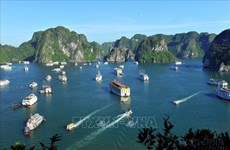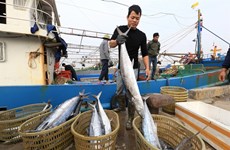HCM City adjusts reservoir to deal with drought
HCM City plans to cope with the 2015-16 dry season as well as the effects of El Nino by transforming crop and breeding models and rotating the release of water from the Dau Tieng reservoir.
 Illustrative image (Source: irri.org)
Illustrative image (Source: irri.org)The city has also asked government agencies to take steps to save water.
HCM City is one of the localities hardest hit by the drought, according to the Southern Hydro-meteorological Station.
The Dau Tieng reservoir supplies water to dozens of hectares of rice and other farm produce fields. It also provides fresh water for households and helps wash away saline water affecting HCM City and the southern province of Tay Ninh.
However, this year the reservoir's water level has been much lower than in previous years.
Recently, the One Member Ltd Company, which manages the irrigation activities at the Dau Tieng - Phuoc Hoa reservoirs, has suspended the release of water for irrigation in order to reserve water.
The water flow from the Phuoc Hoa reservoir is now only 40-50 cubic metres per second, as there has been reduced water flow from the upper river to the reservoir.
Nguyen Tien Lanh, Deputy Head of the One Member Ltd Company that manages irrigation activities at the Dau Tieng - Phuoc Hoa reservoirs, said the Dau Tieng reservoir would resume releasing water for irrigation for Tay Ninh province and HCM City (for 30,000ha) in a few days.
However, given the lack of rain, the company will discuss with agencies in Tay Ninh province and HCM City a plan to rotate the release of water for irrigation to save water for other purposes, including household use.
For instance, the reservoir will release water for irrigation for Tay Ninh province for three days, and then release it for HCM City for household use for four days, instead of releasing water for seven consecutive days for either Tay Ninh or HCM City as it did before.
Bui Thanh Giang, deputy director of Sai Gon Water Corporation (Sawaco), said water supply companies and other agencies under Sawaco had developed plans to cope with the water shortage.
Lanh urged businesses and residents to reduce their use of water as much as possible to ensure a sufficient supply of fresh water when needed.
According to Lanh, to save water, residents should not engage in aquaculture at this time because one hectare of aquaculture consumes 10 times the amount of water needed for plants.
The southern region will face a more serious drought in the 2015-16 dry season than in previous years, according to Le Thi Xuan Lan of the Southern Hydro-meteorological Station.
Dang Van Dung, deputy director of the station, blamed the predicted drought on the ongoing El Nino phenomenon, which refers to the warming of the central to eastern tropical Pacific that occurs on average every two to seven years.
Because of El Nino, the upper Mekong River in Laos and Cambodia has received little rain, reducing the downstream flow of water to southern Vietnam.
In addition, rainfall in many regional provinces has also been lower than the annual average, the expert said.
Of the rainfall volume recorded at 30 observation stations, only six were equal to the annual average rate of the past few years.
The low rainfall has caused low tides on many rivers, including 2.51 metres in An Giang province's Tan Chau town in September, which was significantly lower than the 2.82 metres recorded in 1997, the lowest level ever observed.
Along with the coming drought, saltwater is predicted to enter many rivers in the southern region, including the Mekong, Dong Nai and Sai Gon rivers.
Dung said that all southern localities should store fresh water now and take measures to cope with the possible impact of the coming drought and salinity.
Farmers engaged in aquaculture and agricultural production should closely follow weather developments to make changes when required, especially for the coming winter-spring crop, Dung said.-VNA












